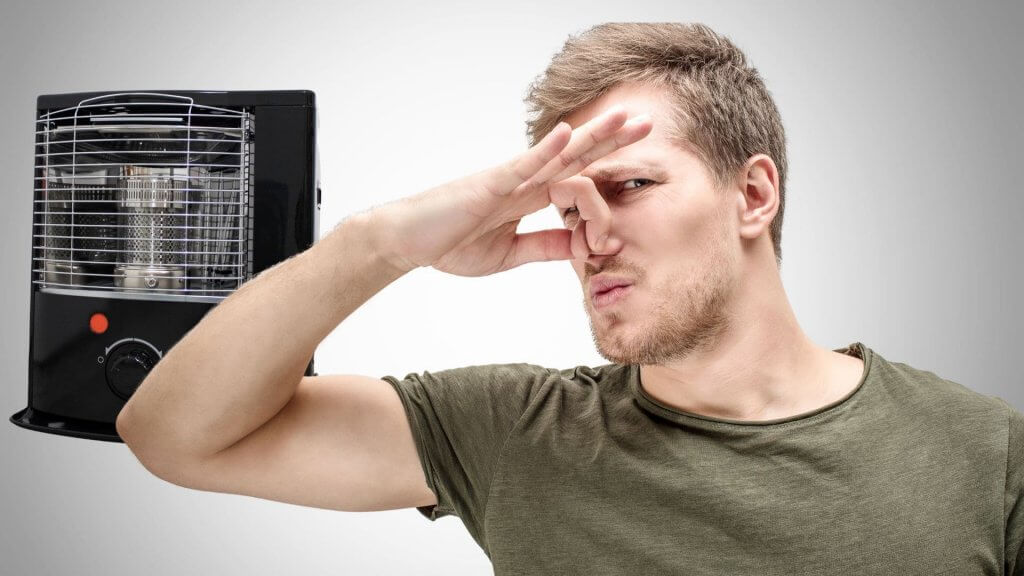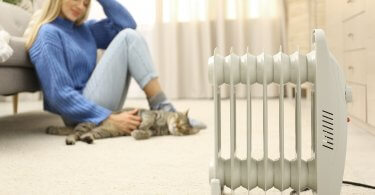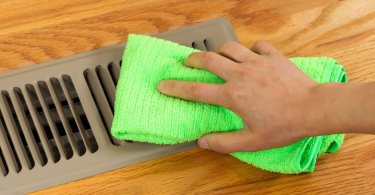A kerosene heater is a portable heating device that works much like a kerosene lamp. There is a circular wick that consists of either fiberglass or cotton in the middle.
A burner unit above the tank is usually filled with 1K kerosene oil, from which the wick sucks fuel via capillary action. Once you light the kerosene heater, the wick heats the kerosene till it turns into gas. The gas heats the air in your house either by convection or radiation.
Kerosene heaters are inexpensive and portable. But there is one potential problem: they have a strong odor that can make you uncomfortable.
So how do you stop a kerosene heater from smelling and producing fumes? There are various small steps that you can do to reduce the extent of the odor.
For instance, you can keep the kerosene in a well-ventilated space to neutralize the odor. Again, you should keep all the heater components well maintained and replace the wick regularly.
Let us discuss some more ways to avoid the unpleasant odor that comes from a kerosene heater.
- What Are the Different Types of Kerosene Heaters?
-
How Can I Stop My Kerosene Heater From Producing Fumes and Smelling?
- 1. Always Use Your Kerosene Heater in a Ventilated Area
- 2. Clean The Tank Once a Month
- 3. The Wick is Set Either Too Low or Too High
- 4. Sieve The Old Kerosene Oil
- 5. Prefer Using 1-K Kerosene Oil
- 6. Add a Bit of Baking Soda to the Tank
- 7. Set the Burner Properly
- 8. Vent Cap Is Damaged
- 9. Purchase Additives to Control Smell
- 10. Replace Wick
- 11. Always Keep the Kerosene Heater in Good Condition
- Final Thoughts

What Are the Different Types of Kerosene Heaters?
1. Convective Heater
Convective heaters are usually circular and found below the wick. These heaters can circulate warm air in all directions. They are used to heat larger spaces.
Some homeowners even say that two convection heaters can heat the entire house when it is too cold outside! The fuel tank is not removable from the convection heater. You have to refuel the tank using a siphon pump.
2. Radiant Heaters
Radiant heaters are rectangular in shape and have a wick and a combustion chamber like a convection heater. But these heaters have a reflector that directs the heat toward people rather than upwards.
Some radiators even have a fan to circulate the warm air in large areas. Most but not all radiant heaters have a removable fuel tank. So the heaters stay in place, and you need to carry the fuel tank for refueling.
Related article: Propane vs Kerosene Garage Heater
How Can I Stop My Kerosene Heater From Producing Fumes and Smelling?
You can stop your heater from producing fumes and smelling in various possible ways. We will discuss some of these ways below.
1. Always Use Your Kerosene Heater in a Ventilated Area
Kerosene heaters consume oxygen while burning. If you keep the kerosene heater in an enclosed space or ill-ventilated area, there will be less oxygen.
This may lead to incomplete fuel combustion and produce harmful gases like carbon monoxide. These gases can affect your health adversely. Carbon monoxide is a colorless and odorless gas, and if inhaled for an extended period, it can even kill you.
Related article: Can Opening a Window Stop Carbon Monoxide Poisoning?
You should always keep the kerosene heater in a well-ventilated space. Try to keep the windows open when you are using the kerosene heater. It will help in reducing the odor of the kerosene heater.
2. Clean The Tank Once a Month
You need to clean the heater after each use. If you are not using a kerosene heater regularly, then clean it at least once a month. This will reduce the extent of burnt matter getting burnt again the next time you fire it up, which will reduce the odor.
First, pour whatever kerosene is remaining into a safe container. Then take a cloth, damp it and wipe all the parts of the tank to remove dust and dirt.
You can even clean the tank with soap and water for the best results. Cleaning will help in reducing the smell coming from the kerosene heater.
3. The Wick is Set Either Too Low or Too High
If the wick of the kerosene heater is set either too high or too low, then it will release an unpleasant odor into the whole room.
If you set the wick too low, then it will not burn all the kerosene. If you set the wick too high, it will burn more fuel than is necessary.
Ensure that the wick is at the proper height so that it will not release excess carbon monoxide. Try to check the lamp’s wick within a gap of one hour to make sure it is at the correct height.
After using the kerosene heater, you should wipe the wick with a damp cloth to remove dust, dirt, and debris. If too much dirt starts building on the wick, it will reduce the efficiency of the kerosene heater. Moreover, it will produce an odor that can be quite foul.
4. Sieve The Old Kerosene Oil
If the kerosene oil in the heater is very old, it might emit an unpleasant odor. You need to sieve the old kerosene oil to remove dust and dirt particles before putting it back in the heater.
Moreover, if the kerosene oil you are using has moisture in it, it will not burn properly and create fumes and gases that will spread in your home.
Related article: Does Kerosene Go Bad, and How Long Does It Last?
5. Prefer Using 1-K Kerosene Oil
Kerosene oil is divided mainly into two types based on its sulfur content: 1K and 2K kerosene oil.
Type 1K Kerosene Oil
The type 1K kerosene oil has 0.04 percent sulfur by weight. It is perfectly safe to use indoors and does not smell unpleasant when used in a heater.
Type 2 K Kerosene Oil
The type 2K kerosene oil has 0.3 percent sulfur by weight. It produces a strong odor as it has high sulfur content. If type 2K kerosene oil is used in indoor heaters, it may be harmful to your health.
6. Add a Bit of Baking Soda to the Tank
Baking soda works well in neutralizing kerosene odors, and it will work wonders on kerosene heaters. You need to add a few grams of baking soda to the tank, each time you use it.
Put the baking soda directly into the tank and give the tank a little shake so that the soda is mixed properly with the remaining kerosene.
7. Set the Burner Properly
If you don’t set the burner properly, then it will allow either too little or too much air into the tank, thus resulting in either incomplete combustion or a smoky smell.
8. Vent Cap Is Damaged
If the vent cap gets damaged, some unburnt vapors can escape. It also allows more oxygen to enter the tank, thus burning more fuel. This will result in a strong kerosene odor throughout your home. So, make sure that the vent cap of the kerosene heater is in good condition.
9. Purchase Additives to Control Smell
You can purchase additives from a hardware shop, which will reduce the kerosene smell and increase efficiency and lessen maintenance. Ensure that the additive you are buying should be compatible with the kerosene heater.
10. Replace Wick
If you have added additives or baking soda to the fuel tank of the kerosene heater, but it is still producing a strong odor, you may need to replace the wick.
11. Always Keep the Kerosene Heater in Good Condition
You should keep all the components of the kerosene heater in good condition. If some of the components are damaged, it can produce an unpleasant smell.
If you have another issue with your kerosene heater, make sure to check my Kerosene Heater Troubleshooting guide.
Related article: Best Non-Electric Space Heaters
Final Thoughts
Clean and pure air is quite essential for our health, so you should inspect your kerosene heater from time to time. If you smell bad odors coming from your kerosene heater, then you can try the tips above to not only neutralize the odor but to also help avoid respiratory problems.





Leave a Comment